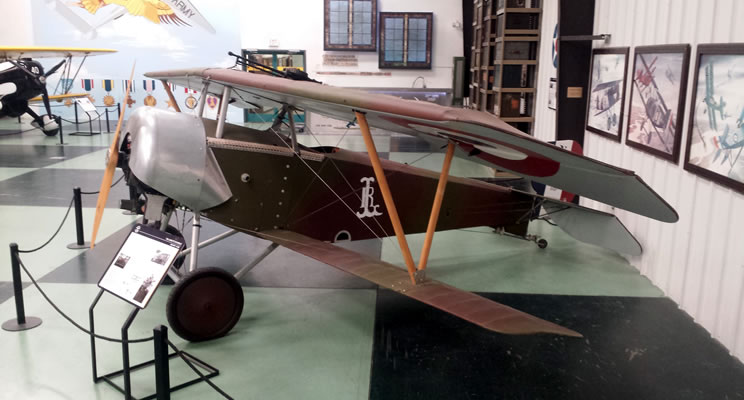“Up-Close Aircraft Day” Focus on French WWI Fighter
Riverside, Calif. – March Field Air Museum is proud to announce the eighth installment of “Up-Close Aircraft Days” on Saturday, August 11, 2018, from 11 a.m. to 3 p.m. As part of this new interpretive program, a different aircraft is featured each month with the next focused on the World War I “Lafeyette Escadrille” Nieuport fighter. On the second Saturday of each month throughout the year, Museum guests will have the opportunity for a close-up look – sometimes climbing stairs to get a close-up view into the cargo bay or cockpit, other times even climbing aboard.
For the upcoming “Up-Close Aircraft Day” focused on the French Nieuport fighter, guests will see how this diminutive single-seat aircraft brought German dominance of the skies over Europe to an end starting in 1916. On this day, visitors to March Field Air Museum will get an up-close view of the Museum’s Nieuport, peering into the cockpit at close range within the main exhibit galleries.
Originally designed for racing, the diminutive Nieuport “Bebe” (Baby) featured an upper wing-mounted machine gun along with ailerons (instead of more primitive wing warping) for rapid maneuvering. The Museum’s Nieuport 11 is a 7/8th scale replica, bearing the markings of the legendary Fighter Ace Raoul Lufbery of the French Air Force’s American volunteer squadron—the Lafayette Escadrille.
The Nieuport’s January 1916 introduction allowed the Allies to meet the Germans on an equal basis. Many of the First World War’s greatest pilots—including Charles Nungesser and George Guynemer—flew Nieuports, as did Kiffin Rockwell of the famed Lafayette Escadrille, the first American to shoot down an enemy aircraft in combat. Although replaced by more advanced aircraft models after only a few short months, hundreds of Nieuport 11s provided vital service at a time when their contribution to the Allied cause was most needed.
To preview the next “Up Close Aircraft Day” happening in August, an F-105B Thunderchief fighter-bomber will be showcased. The Museum’s website features extensive information on each aircraft in its collection of more than 80 total, for those wishing to learn more. Knowledgeable museum docents, dressed in period uniforms whenever possible, will be on hand to assist visitors, provide information and answer questions. The March Field Air Museum website will list upcoming “Up-Close Aircraft Days” and the featured aircraft each month; for more information, visit www.MarchField.org/calendar.
“This new ‘Up-Close Aircraft Days’ program allows March Field Air Museum to showcase the incredible aviation heritage of the U.S. Air Force and military, and especially Riverside’s own March Field,” said Executive Director Paul Hammond. “Today known as March Air Reserve Base, this architectural gem of a military installation in 2018 is commemorating its presence in our community for 100 years. March Field is the West Coast’s oldest continuously operated military airfield, and a birthplace of the modern Air Force that our nation relies upon today.”
Each “Up-Close Aircraft Days” opportunity will be available from 11 a.m. to 3 p.m. on the scheduled date (Museum hours are 10 a.m. to 5 p.m.), and is included with regular Museum admission: $10 for guests ages 12 years and older; $5 for children ages 5 to 11 years; and free for ages 4 and younger. In case of inclement weather, other aircraft may be substituted. March Field Air Museum is a top-rated TripAdvisor attraction located alongside Interstate Highway 215 at Van Buren Boulevard, just south of downtown Riverside and adjacent to March Air Reserve Base. For more information about the Museum, please call 951-902-5949 or visit www.MarchField.org
About March Field’s Centennial
March Field (today’s March Air Reserve Base, located immediately adjacent to the March Field Air Museum) is the West Coast’s oldest continuously operating military airfield. Established in 1918 as the U.S. was embroiled in World War I, it began life as part of the U.S. Army Signal Corps. Following several sleepy years in the 1920s, March Field was expanded in the 1930s as the world again prepared for war. As March Field passed the quarter-century mark, it was busily protecting West Coast skies and training U.S. Army Air Forces personnel for deployment to all Combat Theaters during WWII. Following the war—as the Cold War began—and then continuing for nearly 50 years, March Air Force Base became the U.S. Air Force Strategic Air Command 15th Air Force headquarters and home to a massive nuclear deterrent force.

